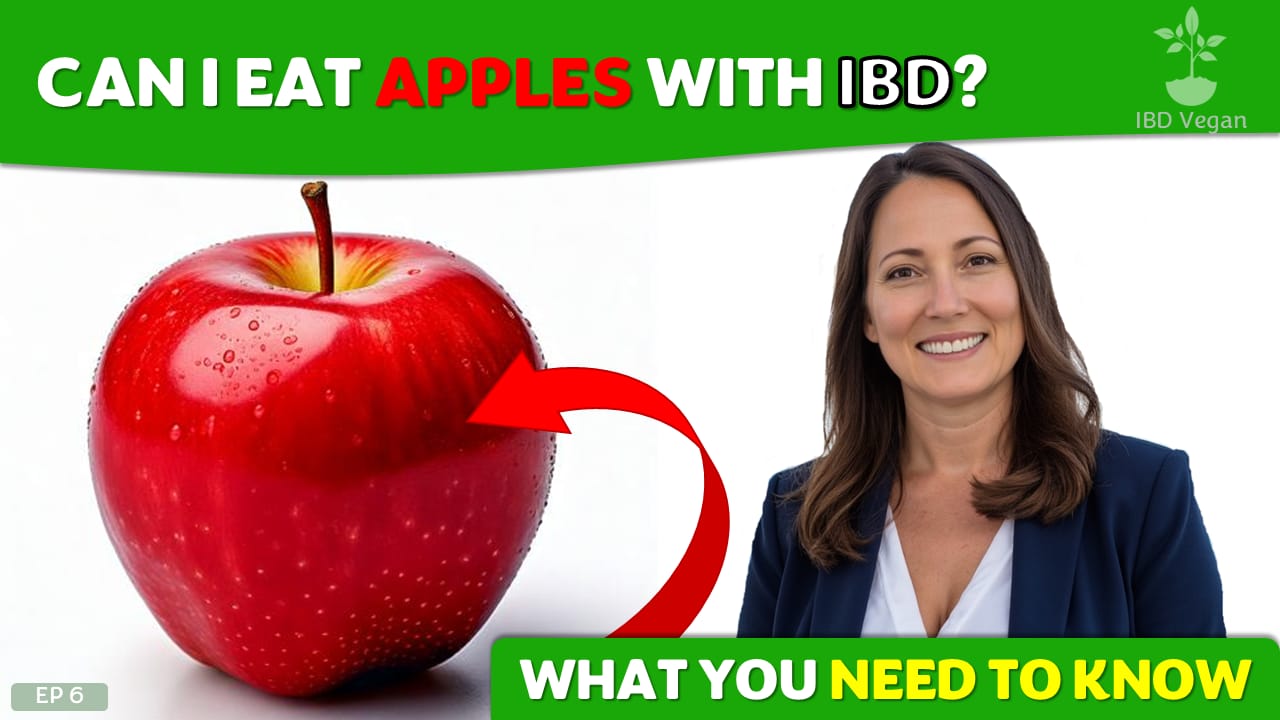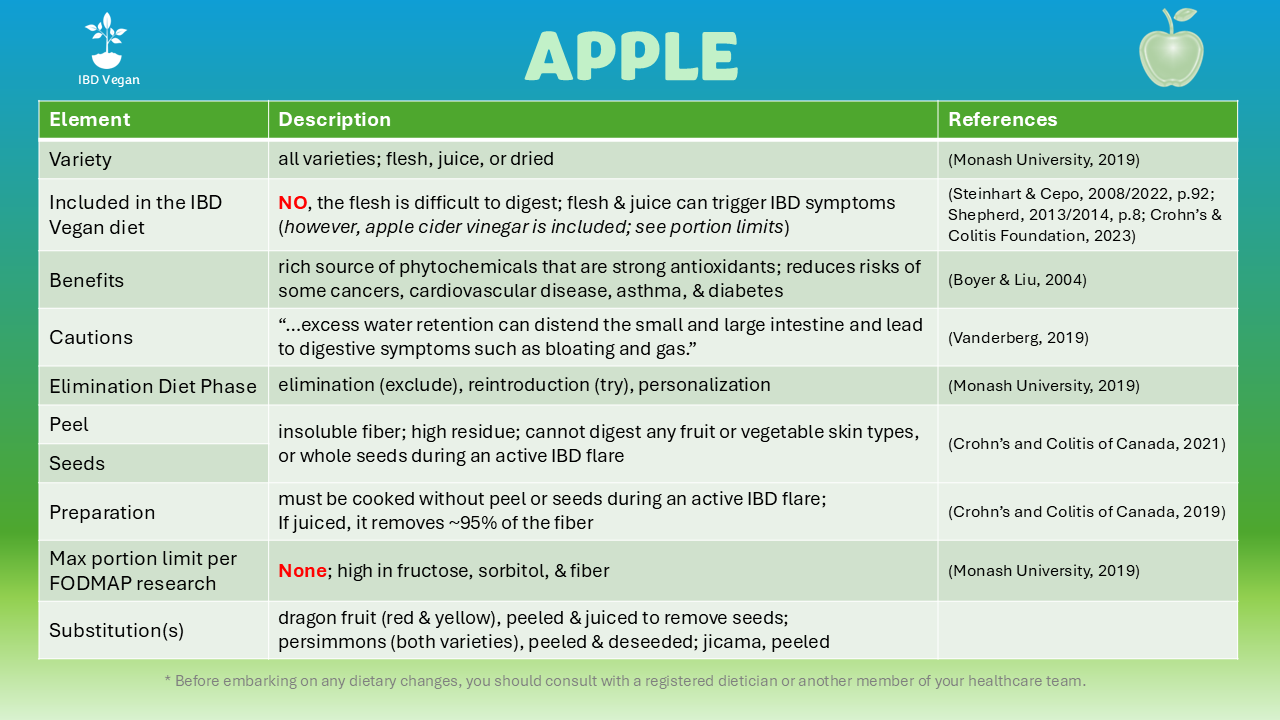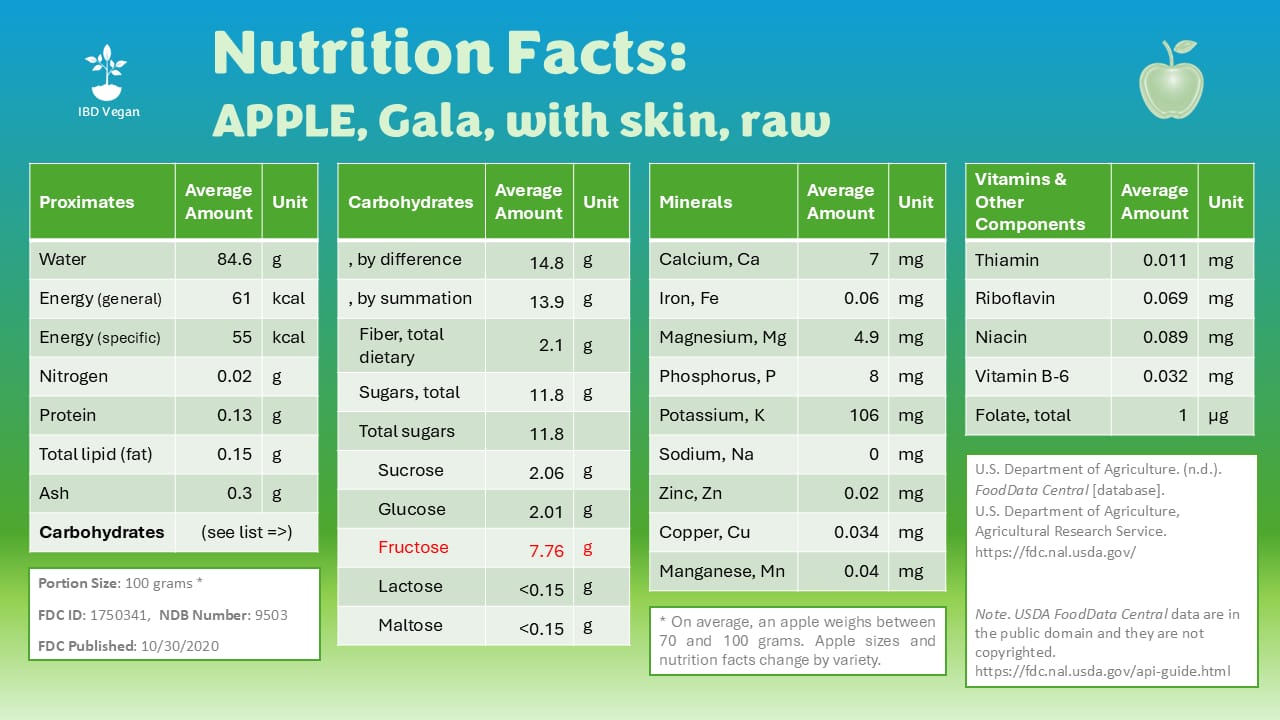- IBD Vegan's Newsletter
- Posts
- Can I Eat Apples with IBD? What You Need to Know | Ep 006
Can I Eat Apples with IBD? What You Need to Know | Ep 006
What is the evidence-based information about apples? What are the nutrition facts for apples?

Can I Eat Apples with IBD? What You Need to Know | Ep 006
Today, I am going to answer the question, “Can I eat apples when I have been diagnosed with Inflammatory Bowel Disease?” Then, I will walk you through the apple nutritional facts. If you have ever wondered about these questions – you are not alone. When you are in the middle of a flare, it can be challenging to try and figure out what you can eat that won’t make your symptoms worse. Here’s what you need to know.
Let’s examine the evidence-based information about apples when it comes to IBD.
Variety: When we talk about apples, this applies to all varieties and specifically I mean the flesh of the apple once the skin has been removed, apple juice, and dried apple pieces.
Are apples included in the IBD Vegan diet? No, this is because the flesh of the apple is difficult to digest when you have IBD, where both the flesh and juice can trigger IBD symptoms. It’s important to remember that the main concern here, is the foods which are safer to eat when you are in the middle of a flare. So, at IBD Vegan we avoid apples during a flare.
As a side note, apple cider vinegar is included in the IBD Vegan diet, just be sure to recognize the portion limits before using it in your recipes.
Benefits: Apples are a rich source of phytochemicals that are strong antioxidants. Research has shown that eating apples reduces the risks of some cancers, cardiovascular disease, asthma from allergies, and diabetes. For more information about varieties, preparation, and amounts -- I encourage you to read the journal article listed in the references section.
Cautions: Apples can cause excess water retention that can distend the small and large intestine, leading to digestive symptoms such as bloating and gas.
Elimination Diet Phase: During the elimination phase, strongly consider excluding apples from your diet. Because of the benefits, you could try to add them back into your diet during the reintroduction phase once you are no longer experiencing an active flare. Depending on how that experiment goes, you can make your own decision about eating apples when you are in remission.
Peels and Seeds: Both peels and seeds are insoluble fiber with high residue. When you have IBD, you cannot digest any fruit or vegetable skin types, or whole seeds during an active flare. So, if you try to experiment with apples during the reintroduction phase, be sure to peel them and remove any seeds.
There are only a few food items that can be tolerated raw, when you have IBD. So, if you try to experiment with apples during the reintroduction phase, be sure to cook them thoroughly. Juicing the apple removes about 95% of the fiber, but remember even apple juice can trigger IBD symptoms. If you are going to try apple juice, wait until the reintroduction phase to experiment.
Portion Limits: The maximum portion limit per FODMAP research is – none. This is because apples are high in fructose, sorbitol, and fiber; all of which can trigger IBD symptoms. The research coming out of Monash University is updated frequently, so be sure to periodically check to see if this changes at all.
Substitutions: If you are experiencing an active flare and you find you are missing the flavor profile of apples, do not despair as there are a few options for substitutions. First, dragon fruit (both the red and yellow varieties) can be peeled and juiced to remove all those tiny black seeds.
Second, both varieties of persimmons taste like cooked apples in apple pie. Be sure to peel them and remove the single large seed, depending on which variety you choose. Persimmons are one of my favorite substitutes for apples, however they are only available a few months out of the year. If you’ve never tried them before, I highly recommend persimmons.
Third, a root vegetable called jicama is a solid option after it has been peeled. You can usually find them in health food stores or a local Asian market.
Card: Here is the complete card for apples.

Stay tuned for the upcoming apple nutrition facts.
If you are new to the world of FODMAPs, for more detailed information, check out my segment on FODMAPs here. I will put the link down in the description section. Be sure to check it out because this is an important part of understanding dietary needs with an IBD diagnosis.
Nutrition Facts: What are the nutrition facts for apples?
Before we dive into that, remember before embarking on any dietary changes, you should consult with a registered dietician or another member of your healthcare team.

Here, we are looking at an apple of the Gala variety. If you use other varieties, use the resource listed in the lower right corner of the screen to access the database. For those of you listening to the podcast, this is the FoodData Central database by the United States Department of Agriculture located at fdc.nal.usda.gov/.
You will note the nutrition facts are provided as keeping the skin on the apple, even though the skin is difficult to digest for people diagnosed with IBD. There were no other options showing nutrition facts without the skin, so use this as your best approximation.
The portion size used was 100 grams. Keep in mind, on average, an apple weighs between 70 and 100 grams. You will have to adjust the portion size and average nutrition amounts accordingly.
Lastly, note the high level of fructose in this apple variety. This shows you how apples are considered as high-FODMAP and should be avoided in the elimination phase when you are experiencing an active flare.
This is IBD Vegan. I am your host, Alexis, and I want you to remember, it is possible to become more educated, resilient, and feel empowered for a better quality of life.
--------------------
REFERENCES
🗎 Boyer, J., & Liu, R. H. (2004). Apple phytochemicals and their health benefits. Nutrition Journal 3(5). https://doi.org/10.1186/1475-2891-3-5
🗎 Crohn’s & Colitis Foundation. (2023). Diet and Nutrition. Crohn’s & Colitis Foundation http://www.crohnscolitisfoundation.org/
🗎 Crohn’s and Colitis of Canada. (2019). Diet and Nutrition: Eating with IBD. Crohn’s and Colitis of Canada. https://crohnsandcolitis.ca/About-Crohn-s-Colitis/IBD-Journey/Diet-and-Nutrition-in-IBD/Eating-and-Drinking-with-IBD#
🗎 Crohn’s and Colitis of Canada. (2021, November). IBD Kitchen (Part 1). Crohn’s and Colitis of Canada. Ebmed Inc. https://crohnsandcolitis.ca/Crohns_and_Colitis/documents/Support/IBD%20Kitchen/EBMed-IBD-Kitchen-Part-1_NOV29-2021_1.pdf
🗎 Monash University. (2019). High and low FODMAP foods. Monash University. https://www.monashfodmap.com/about-fodmap-and-ibs/high-and-low-fodmap-foods/
🗎 Shepherd, S. (2013/2014). The Low FODMAP Diet Cookbook. The Experiment
🗎 Steinhart, A. H., & Cepo, J. (2008/2022). Crohn's & Colitis Diet Guide (3rd Ed.). Robert Rose Inc.
🗎 Vanderberg, M. (2019, March 15). 31 foods you shouldn’t eat on the low-FODMAP diet. Business Insider. https://www.businessinsider.com/high-fodmap-foods-2019-3
--------------------
HEALTH DISCLAIMER
⚠️ This content is not meant to replace medical or other professional advice. We strongly encourage you to seek advice from a licensed nutritionist, medical doctor, or other professional for your specific needs, if necessary.
Reply